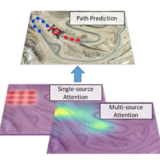|
I am motivated by solving high-impact problems with cutting-edge AI algorithms. I currently work at Ambient AI which aims to detect security incidents in real time from camera streams with deep learning algorithms while preserving privacy. As a Staff Applied Research Scientist, I enjoy working as an individual contributor and a team lead, alternating between quick AI prototyping, shipping production software, and designing & implementing the company AI roadmap. Previously, I spent time in the Perception team of Tidal at X - formerly Google [X], at LinkedIn as a Machine Learning research intern, and at The Boston Consulting Group as a data scientist and consulting intern. I earned a MSCS from Stanford where I did research in three AI labs. I worked on Speech Recognition at the Stanford Machine Learning Group, directed by Andrew Ng, I researched in Computer Vision at the Stanford Computational Vision and Geometry Lab led by Silvio Savarese, and developed AI applications for Healthcare at the Mobilize Center headed by Scott L. Delp. Previously I explored spatio-temporal statistics research at NYU under Juliana Freire from the Center for Data Science at NYU, and studied at Ecole Polytechnique in France. |

|
|
I am interested in how machine learning and statistics can enhance machine perception. Here are research projects I took part in and the associated publications. |

|
Our method predicts the future motion of a car from past positions and top-down views of the navigation environment, e.g. a racing circuit. We developed a hybrid attention mechanism combining soft attention and DRAW attention methods. Our technique is state-of-the-art, allows to visualize the elements of the navigation scene that led to the prediction, and could lead to applications in drone piloting or surveillance. Code to be released soon. |
 |
Detecting favorable hamstring surgery candidates among patients with Cerebral Palsy, a neuro-motor condition. We built a Bayesian Network model which provides an interpretable graph of variables and computes predictions of post-surgical patient state from a small number of variables. Using the system's predictions to retrospectively recommend patients for surgery led to increased prediction compared to the surgery decisions of the clinical team. Working on a journal paper, code and paper not released yet. |

|
Surveyed spatio-temporal anomaly detection methods and contributed to bridge the gap between theory and application in the field by extensive experiments with state-of-the-art methods. After showing how all techniques could be seen as a combination of essential blocks (space-time modeling, anomaly extension definition, baseline definition...), we illustrated the impact of key technique design choices on the anomalies detected on a NYC taxi density dataset. |

|
Investigating Deep Learning techniques for audio sentiment understanding. Challenges are the presence of multiple speakers and the high audio length. I leverage emotion recognition techniques from speech literature and I work on jointly learning speech and language cues for sentiment understanding. The project is part of a global effort of an industry partner to develop general audio intelligence. |
|
|
 |
Detecting whether an input article agreed, disagreed or was neutral regarding various stances - e.g. "Prime Minister flew to Europe last week". Achieved accuracy of 80.8% with conditional LSTM after tackling long sequence challenge with Attention mechanism and class imbalance issues. Work was part of the Fake News Challenge. Code to be released soon. |
|
In Fall 2017 was a Teaching Assistant for Andrew Ng and Dan Boneh's class CS229 Machine Learning. |
|
|